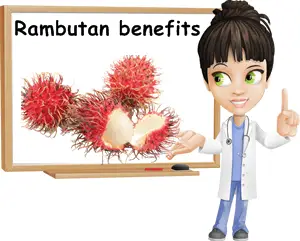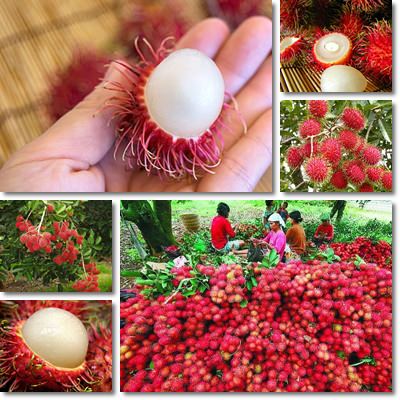The rambutan fruit (Nephelium lappaceum) is the hairy version of the lychee fruit and quite the tropical delicacy. Commonly found throughout Southeast Asia, the rambutan represents a moderately low source of essential nutrients, notably manganese, vitamin C, niacin and magnesium. The fragrant flesh lacking color, it does not boast much antioxidant value, but does contribute to immune system, cardiovascular, muscle, nervous system and digestive health.
Rambutan skin is inedible, but quite rich in potent antioxidant and anticancer polyphenols such as caffeic acid, ellagic and gallic acid. Antioxidants protect cells and DNA against damage caused by reactive oxygen molecules called free radicals, preventing the development of chronic disease. Despite its humble nutritional value, the fruit boasts several impressive health benefits ranging from weight management and constipation relief to tonic, antioxidant and anti-inflammatory effects.

What does rambutan look like?
Rambutan is quite the interesting fruit. It looks very much like an extremely hairy lychee fruit or a pink-red sea urchin with incredibly soft spines. Most cultivars bear small, oval, pink-red fruit with soft pink and bright green hairs covering the entire skin. When ripe, the skin may turn a darker red. Yellow-orange varieties exist as well. The flesh is whitish, shiny, almost see-through, very similar to that of litchi. Each fruit contains one rather pale, soft brown seed. After 6-10 years, the trees start bearing greater amounts of fruit and the view of a rambutan tree heavy with fruit is truly lovely. The fruit hang in beautiful bunches of vivid colors, sagging lazily, awaiting to be picked and enjoyed.
What does rambutan taste like?
Again, very similar to lychee or litchi. The fruit are sweet and fragrant with a slightly acidic aftertaste. Also see the benefits of lychee, litchi.
Are rambutan seeds edible?
Answer: yes, they are. Raw seeds are soft and very bitter, hence their reputation of being poisonous (but they are not). However, if you cook them well, they should lose most of their unpalatable bitterness. Roasted rambutan seeds taste somewhat like roasted, bitter chestnuts or like slightly bitter popcorn.
How to eat ripe rambutan
Simply put pressure on the skin of a ripe fruit and it should break easily, allowing you to take out the flesh and enjoy it. You can also cut them around the middle with a knife, pull one half of the skin and then squeeze the fruit out. If you are too eager to try them, just take a bite out of one rambutan to crack the soft skin and enjoy its delicious inside.

What is rambutan good for?
The rambutan is one very popular fruit in Southeast Asia, comparable to apples in Europe and America. Considering its popularity, chances are you will see the fruit either in the produce section at your local supermarket when it’s in season or at a market during your travels. And if you are going to try it, it’s best to know as much as possible about its nutritional value and health benefits and generally what to expect. See below my list of the top 5 nutrition facts and health benefits of rambutan:
Boosts energy levels naturally
Rambutan fruit have a high carbohydrate content (around 20%) thus contributing to boosting energy levels. Carbohydrates regulate blood sugar levels, providing energy for the body to use to perform various physical and cognitive activities. If there is a sufficient carbohydrate intake, the body does not make use of proteins for making energy. Instead, it uses them to perform essential cellular functions such as catalyzing biochemical reactions of vital importance.
Helps prevent and relieve constipation
With around 3 g of dietary fiber/100 g pulp, rambutan contributes to relieving constipation. Dietary fiber adds bulk to stools, encouraging their elimination. Also, the fruit has a high water content which helps us stay hydrated, preventing constipation. According to traditional Chinese medicine, eating rambutan can help kill and expel intestinal parasites, probably due to the fruit having antifungal properties.
Contributes to maintaining a steady weight
Rambutans have around 78 kcal/100 g. If you are looking to maintain a steady weight, you can substitute candied sweets with sweet fruits such as rambutan or lychee and significantly reduce your calorie intake.
Good vitamin C and manganese content
Eating a handful of rambutan fruit can supply our body with good amounts of vitamin C and manganese, two potent antioxidants which protect against oxidative stress, premature aging and chronic disease. Vitamin C in particular promotes collagen production, collagen being a protein that helps maintain the structure of our blood vessels and skin.
Boasts antioxidant and anticancer activity
The antioxidants in rambutan fruit were found to protect against free radical damage that can alter cells and DNA causing mutations that lead to cancer, neurodegenerative diseases and so on. In addition to vitamin C and manganese, rambutan also contains p-Coumaric acid, caffeic, ellagic and gallic acid, four polyphenols which exhibited excellent in vitro anticancer activity.
P-Coumaric acid, for instance, is suggested to help lower stomach cancer risks, while gallic acid, also found in grape seeds, may help prevent and delay the progression of neurogenerative diseases such as dementia. Caffeic and ellagic acid were also shown to be potent anticarcinogens which can help stop cancer cell proliferation. However, further studies are needed before promoting any substance as a cancer treatment-proper.
Conclusion
Rambutan may not be the most nutritious fruit, yet it still provides a good addition to one’s diet. It is sweet, juicy and contains good amounts of vitamin B3 as well as antioxidants such as manganese and vitamin C. It provides good energy levels as a result of its moderate carbohydrate content. Moreover, seen that it practically has no fat, it is safe for anyone suffering from cardiovascular disease. Overall, rambutan is a good fruit to eat on a hot day when you are feeling thirsty and craving something sweet.
